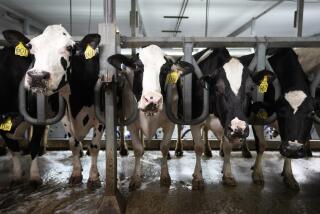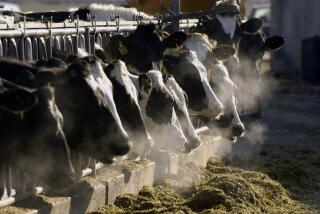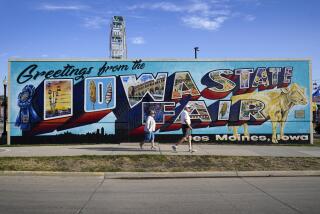The Beef About Clones
- Share via
CHARLO, Mont. — After 30 years of raising cattle the old-fashioned way, Larry Coleman decided six years ago to plunk down $60,000 to clone the best Limousin breeding bull these parts had ever seen.
First Down, a hulking black creature that died in 1999, produced semen that sold for as much as $700 a vial -- and he filled thousands of them. Now a new First Down, along with fellow clones Second Down and Third Down, are ready to kick off their careers as professional sires. Second Down has already been relocated to a semen collection facility in Billings.
Fliers have been printed. A three-ring binder contains orders from eager customers. Thousands of semen straws are waiting in a freezer.
And waiting ... and waiting ... and waiting.
“I thought for sure we’d have our investment back by now,” Coleman said.
Blocking Coleman’s leap into the cloning revolution is the Food and Drug Administration, which despite four years of study has yet to rule that products from cloned animals are safe to eat.
Thousands of other ranchers are in similar straits, holding back prospective steaks and milk as the FDA studies the issue, although some meat is quietly making its way to the dinner table.
The main concern is not the clones themselves, which are too precious to butcher for burgers. Rather, the government is worried that milk from clones or meat from their offspring might pose some unknown health risk.
The FDA did its own study in 2003 and found that “food products derived from animal clones and their offspring are probably as safe to eat as food from their non-clone counterparts.”
But the ranchers acknowledge there is an inescapable queasiness about cloning that complicates the government’s decision. Even though the first animal clone -- Dolly the sheep -- was born nearly a decade ago, the public still has a hard time grappling with the new science.
It’s even harder to think about eating it.
According to a survey last year by the International Food Information Council, a trade group, 62% of consumers said they would be “very unlikely” or “somewhat unlikely” to buy meat, milk and eggs from cloned animals.
A separate poll conducted by Gallup found that 64% of American consumers believed cloning animals was “morally wrong.”
As Carol Tucker Foreman, director of the Consumer Federation of America’s Food Policy Institute, explained: “The yuck factor is very large.”
*
Lounging in a slushy pen with a few dozen other cattle, First Down and Third Down don’t seem like much of a threat to the nation’s food supply.
Their faces and hindquarters caked in mud, they look pretty much like all the other bulls -- except bigger.
Coleman can’t help but think of the original when he looks at the two clones.
“Every wrinkle -- everything about them, even the disposition and character -- are the same,” he said nostalgically.
The spirit of the first First Down looms large on the Coleman ranch.
A metal cutout of his blocky silhouette is soldered to the family’s mailbox. His jet-black likeness adorns the tan baseball caps worn by the Coleman clan. More than 5,500 calves are registered as his offspring.
When he was born on the ranch in 1994, First Down was small like a puppy dog, hardly remarkable. But he soon outgrew his fellow calves. His yearling weight of 1,580 pounds made him several hundred pounds heavier than many adult Limousin bulls.
In the rating system for breeding bulls, First Down had phenomenal stats. He ranked in the top 1% of his breed in terms of growth, docility, muscle marbling and scrotum size, a measurement used to predict the fertility of his daughters.
“The genetics of a bull like that are of extreme value to our population,” said Kent Andersen, executive vice president of the North American Limousin Foundation in Englewood, Colo.
He declared First Down the “most influential” Limousin in the country since the first bulls arrived from France in 1971.
He couldn’t have been born at a better time.
Coleman and his wife of 35 years, Anita, live a modest life in a town of 439 where the lone grocery store sells farming magazines at the checkout stand. He manages about 800 head of cattle on land homesteaded by his grandfather in 1908. Larry’s father, brother, nephew and one son all live within a few miles.
In the mid-1980s, a depressed farm economy forced Coleman’s ranch into bankruptcy.
First Down saved them. Coleman entered 10 of First Down’s sons in the 1998 stock show and won the grand champion prize. Animals sired by First Down commanded a hefty premium at auction.
“He was our million-dollar bull,” Coleman said, exaggerating slightly.
The idea of cloning First Down was not obvious to Coleman. The technology was still experimental at the time: The first calves cloned from an adult cow were born in Japan in 1998. But as word of the breakthrough spread, suggestions made their way to Charlo.
A few months before First Down died of natural causes, Coleman sent a small piece of the bull’s ear to Infigen Inc., a biotech company in DeForest, Wis.
To clone an animal, scientists start with a piece of ear skin and mince it up in a lab. Then they induce the cells to divide in a culture dish until they forget they are skin cells and regain their ability to express all of their genes. Meanwhile, the nucleus is removed from a donor egg and placed next to a skin cell. Both are zapped with a tiny electric shock, and if all goes well the egg grows into a genetic copy of the original animal.
The first two clones died. It took a couple of years, but three healthy clones were delivered to Charlo in the spring of 2003.
Soon after, Coleman received a reassuring message on his answering machine from John Matheson, a senior regulatory review scientist with the FDA’s Center for Veterinary Medicine. “A decision on whether or how to regulate them is probably going to be into the early spring of ‘04,” Matheson said.
That would be just in time for Coleman’s clones to reach sexual maturity.
The spring breeding season passed without a decision. The first batches of semen stayed put in a freezer.
Now, the melting snow reminds him that spring is approaching again.
“The breeding season is coming upon us,” he said, “and if you don’t hit that, you got to wait a whole year.”
*
Cattle ranchers have long embraced advanced reproductive technologies in their quest to efficiently produce higher-quality milk and beef.
In the 1960s, they began using frozen semen and artificial insemination. Then, they employed in vitro fertilization.
Such techniques allow prized animals to pass on their desirable genes -- but they don’t ensure those genes will make it to the next generation.
“When you breed animals, they only donate 50% of the DNA, and it’s totally random,” said Cindy Daley, a professor of animal science at Cal State Chico’s College of Agriculture. “Cloning takes the guesswork out of it.”
A squad of First Downs, fathering legions of desirable offspring, could raise the quality of the entire Limousin breed.
But as with any new technology, there are always unknowns.
Some scientists believe all cloned animals have subtle genetic defects that arise from their unnatural start to life. Dolly the sheep, for example, suffered from arthritis and died at an unexpectedly early age.
The Japanese have conducted the most thorough studies of cloned meat.
The scientists, from the Operation of Urgent Research for Utilization of Clone Technology, subjected meat from cloned cattle to a battery of tests.
They compared its chemical composition to samples of regular beef. They analyzed amino and fatty acids. They subjected pieces to simulated gastric and intestinal juices to measure digestibility. They fed the meat to rats for 14 weeks and tracked their motor activity, reflexes, grip strength and other characteristics. Then they killed the rats and conducted autopsies.
In a 2004 report, the researchers concluded that there were “no significant biological differences” between natural and cloned beef.
The U.S. FDA began studying the safety of food produced from cloned animals and their offspring in 2001. The agency commissioned a report from the National Academy of Sciences, which found that clones present “a low level of food safety concern” based on the limited data available.
The FDA issued a draft summary of its risk assessment in 2003, concluding that cloned animals and their offspring posed no increased risk to food safety.
However, the FDA emphasized that it had “made no policy decision that these products may be sold” and asked ranchers to voluntarily keep clones and their offspring out of the food supply until a final decision was made.
FDA officials won’t say when they expect that to happen or discuss other aspects of their deliberations.
The North American Limousin Foundation decided on its own to include clones in its breed registry only if their owners refrain from selling semen until the FDA signs off.
Everyone assumed it would be a short wait.
“We were pretty confident that science would prevail in a timely fashion,” Andersen said.
*
Time is relative in a place like Charlo. Nestled in a flat valley in the shadow of the Rocky Mountains, it is a landscape where life often seems measured more by season than by clock.
Downtown Charlo is little more than a widening in Montana Highway 212. There is a post office, a fire department, a grocery store, a senior center, an Exxon station, Tiny’s Tavern and the M Bar 7 Cafe.
Amber Doty, the cook, is a meat-eater in a community built on cattle. But the thought of cloned beef is just too futuristic for her.
“It’s just not right to clone anything,” she said.
Even if regulators declared the meat safe, she wouldn’t eat it. “You never know how well science works,” she said.
Barry Ambrose, who guides tourists on the Lewis and Clark Trail and prefers to eat elk he kills with his own bow, hasn’t caught up to the idea either.
“I just don’t like fooling around with nature,” said Ambrose, son of the late historian Stephen E. Ambrose.
Such ambivalence in the heart of cattle country doesn’t bode well for those anticipating a favorable FDA decision.
“The scientists and ranchers always want to say it’s just about the science, but it’s not,” said Foreman of the Food Policy Institute. “We have all sorts of emotional attachments to our food. And to think that people are going to choose without this question coming up -- it’s just not right.”
Most ranchers are simply exasperated. Out on the plains, where tens of millions of cows graze each year, a steak is a steak is a steak.
Ranchers and dairy farmers are losing patience with the moratorium.
Frank Regan spent $65,000 to clone his prized Holsteins Dellia and Deborah. Now, he has five clones producing nearly 500 pounds of milk each day at his family farm in Waukon, Iowa.
He can’t sell the milk so he’s diverting it to a tank to feed calves. All he can do is wait for the FDA.
“It’s kind of like taking a girl out for about 10 years and then telling her you’re never going to marry her,” he said.
In August, Colby Collins of Frederick, Okla., will begin delivering the first of 50 calves sired by a clone of Full Flush, a popular Chianina bull from a nearby ranch.
Collins could have bought semen from the real Full Flush for $50 a straw. Instead, he paid just $20 for semen from one of the five Full Flush clones.
“When you can cut a dollar here and a dollar there, you’ve got to do it,” he said.
The calves will be sold to youngsters, who will raise them for a year and enter them in county fairs and farm competitions, collectively known as the club calf circuit.
The circuit has come to occupy an odd spot in the clone conflict. Everyone knows the club calves will be sold for slaughter after their last turn in the show ring. But no one likes to dwell on it.
Don Coover, a vet and semen broker in Galesburg, Kan., has promised two clone offspring to kids to raise for the circuit. The FDA has no way to track them.
“They will go into the food chain, no question, in six or eight months,” he said.
And that’s just the beginning.
“I’m selling hundreds -- maybe thousands -- of units of semen from bulls that were cloned,” he said. “They’re going to be slaughtered, and the FDA can’t do anything about it.”
There is no way to distinguish calves fathered by clones from those fathered by the original bull. A DNA analysis would reveal only that they have different mothers.
“If this turns into a crime,” Coover said, “it would truly be the perfect crime.”
More to Read
Sign up for Essential California
The most important California stories and recommendations in your inbox every morning.
You may occasionally receive promotional content from the Los Angeles Times.











